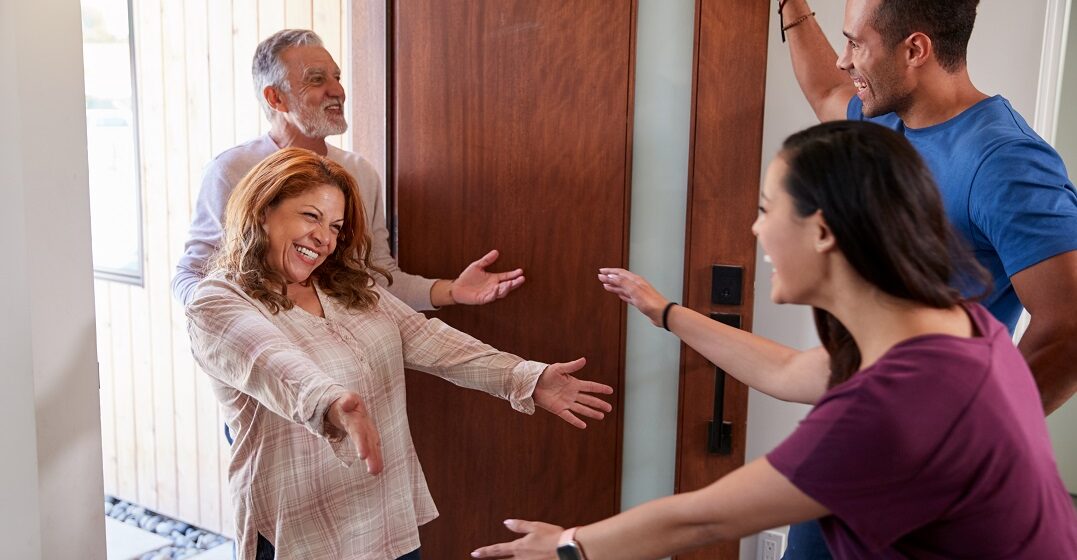Updated on October 11, 2023

10 ways to greet someone in Spanish

How do you greet someone in Spanish? There is more to it than just saying Hola! Knowing different greetings is useful. In English, you speak to people with a different style and formality depending on the context. When you see your grandma, you say “Hi Granny, how are you?”. Arriving at a fancy dinner date, you say “Good evening sir, we have a reservation.” Meeting your friends at the bar, you might show up hollering “What’s up everybody?”. Spanish has the same differences. When you learn Spanish online or in a classroom, it’s normal to use the same greeting with your teacher. That said, using different greetings in Spanish will help you to sound natural around Spanish speakers. If your goal is to eventually have a beginner Spanish conversation, start by practicing to greet people in various ways.
Pronunciation: OH-la
Everyone knows hola, meaning “hi” or “hello” in Spanish. It’s such a popular greeting that it has made its way into the spoken conversation even in English-speaking countries. It’s casual, friendly and goes great with a little wave. Plus, it’s a good reminder that in a proper Spanish accent we never pronounce the “h”.
Pronunciation: BWEN-os DEE-ahs
“Good mornings ” is a formal option to greet people in Spanish. This Spanish greeting is used with people older than you as well as strangers. For example, say this when you walk into a restaurant for breakfast. Buenos días ends at 12pm so don’t forget to switch over to buenas tardes in the afternoon.
Pronunciation: BWEN-as TAR-des/NO-chess
“Good afternoons/evenings” can be used as a formal greeting during the day and into the early evening. Use buenas noches again as a “good night” send-off before you go home or go to bed.
Pronunciation: MOO-ey BWEN-as
This Spanish greeting “Very good [ones]!” is almost the same greeting as above but the word tardes/noches is implied without you saying it (muy buenas [tardes]). This greeting emphasizes that your afternoon/evening is extra good. You will hear this greeting when somebody is in a chipper mood.
Pronunciation: CO-mo eh-STAS/STA/STA
“How are you (informal/formal/plural)?” is a simple way to greet a friend or family member. Use the informal version for friends, peers, and younger people. Use the formal version for anyone older than you or in a position of authority like your boss. Use the plural version to address everyone: Saludos a todos, ¿cómo están? Much like in English, you can expect a simple response of “bien” or “fine” rather than a detailed answer.
Pronunciation: ke TAL
This Spanish greeting means “What’s up?” As you might guess, it’s informal and typically used within your friend circle. What’s up? Not much. If somebody asks you ¿Qué tal? you can reply nada (NAH-thah) meaning “nothing”.
Pronunciation: ke PA-sa
This Spanish greeting translates literally as “What’s wrong?” This one is also informal and used with friends or young people in the street. It is also common to greet somebody that looks confused, upset, or lost.
Pronunciation: ke Ah-ses
“What are you doing?” or “What are you up to?” is a good greeting to use when you meet up with a friend and they are preoccupied. For example, use this one if you see a friend at the library working on homework or if you see a co-worker at a cafe typing on their laptop.
Pronunciation: EY
This one is an extra casual way to say “hey”. Use this greeting in Spanish to announce you have arrived while walking up to your best friends.
Pronunciation: ah-LO
The Spanish greeting ¿Aló? in question, format is how Chileans answer the phone. When used as an exclamation, it has the same meaning as the English phrase “Yoo-hoo!” This greeting in Spanish can be used to get the attention of your friend walking in the street. ¡Aló Marta! “Yoo-hoo Martha! Hey there Marta!”
Now you have 10 different ways to greet people in Spanish. These greetings are universal and used in every Spanish-speaking country by people of all ages. Get comfortable with saying hello in Spanish and soon you will graduate to basic conversations.